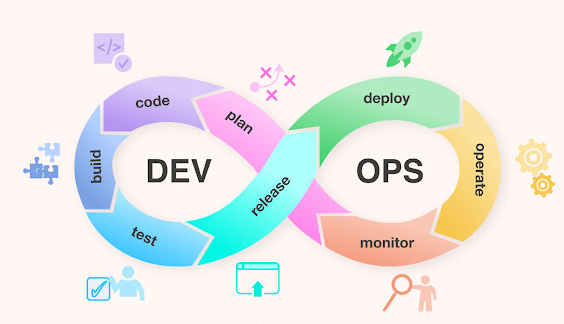DevOps is a set of practices and cultural philosophies that aim to improve collaboration and communication between software development (Dev) and IT operations (Ops), and quality assurance (QA) teams within an organization. It focuses on streamlining the software delivery process, increasing deployment frequency, and ensuring a more reliable and efficient software development lifecycle (SDLC).
Key Principles and Objectives of DevOps:
1. Collaboration: DevOps encourages collaboration and communication among development, operations, and other stakeholders involved in the software development process.2. Automation: Automation of processes, such as code deployment, testing, and infrastructure provisioning, is a core principle. This reduces manual errors and accelerates the delivery pipeline.
3. Continuous Integration (CI) and Continuous Deployment (CD): CI involves frequently integrating code changes into a shared repository, while CD automates the deployment of code changes into production environments.
4. Monitoring and Feedback: Continuous monitoring and feedback loops help identify issues early, allowing for faster responses and improvements.
5. Agile Practices: DevOps often incorporates agile methodologies to enable quick iterations, flexibility, and adaptability to changing requirements.
Core Practices and Tools in DevOps:
1. Version Control Systems: Such as Git, SVN, or Mercurial, enable teams to collaborate, track changes, and manage code versions efficiently.2. Configuration Management: Tools like Ansible, Puppet, or Chef automate the configuration and management of infrastructure and environments.
3. Containerization and Orchestration: Technologies like Docker for containerization and Kubernetes for orchestration allow for consistent deployment across different environments.
4. Continuous Integration and Deployment Tools: Jenkins, CircleCI, Travis CI, etc., help automate building, testing, and deploying code changes.
5. Monitoring and Logging: Tools like Prometheus, ELK Stack (Elasticsearch, Logstash, Kibana), or Splunk aid in monitoring performance, identifying issues, and gathering insights.
Benefits of DevOps:
Faster time to market for software releases.Increased deployment frequency and reliability.
Improved collaboration and communication among teams.
Enhanced efficiency through automation.
Better quality and stability of software applications.
The DevOps lifecycle represents the sequence of stages involved in the development, deployment, and management of software applications while integrating DevOps practices. It encompasses various phases, each contributing to the seamless delivery of software and continuous improvement. Here's an overview of the typical DevOps lifecycle stages and how they work together:
1. Plan
Objective: Define the scope, requirements, and goals of the project.Activities: Establish the development roadmap, prioritize tasks, and set project milestones.
Tools: Project management tools like Jira, Trello, or Asana are used for planning and tracking.
2. Code
Objective: Developers write and review code changes.Activities: Writing and testing code, implementing best practices, and ensuring version control.
Tools: Version control systems like Git, code editors, and code review tools like GitHub or Bitbucket.
3. Build
Objective: Compile the code into executable software artifacts.Activities: Compiling, packaging, and transforming source code into deployable artifacts.
Tools: Build automation tools such as Maven, Gradle, or Jenkins for continuous integration.
4. Test
Objective: Verify and validate the software against defined requirements.Activities: Automated and manual testing, including unit tests, integration tests, regression tests, and user acceptance tests (UAT).
Tools: Testing frameworks, such as Selenium, JUnit, or Postman, and continuous testing tools.
5. Deploy
Objective: Automate and manage the deployment of software to various environments.Activities: Release automation, configuration management, and deploying to staging, production, or other environments.
Tools: Deployment automation tools like Ansible, Puppet, or Kubernetes.
6. Operate
Objective: Ensure the application runs smoothly in the production environment.
Activities: Monitoring system performance, logs, and addressing issues or incidents as they arise.
Tools: Monitoring tools such as Prometheus, ELK Stack, or Nagios for real-time monitoring.
7. Monitor
Objective: Collect data to analyze the performance and user behavior of the application.
Activities: Gather metrics, logs, and feedback to improve application performance and user experience.
Tools: Analytics tools, logging tools, and APM (Application Performance Monitoring) solutions.
Continuous Feedback and Improvement:
The DevOps lifecycle is iterative, encouraging continuous feedback from users, stakeholders, and operations to improve each phase continuously.
This feedback loop feeds back into the planning phase, guiding future iterations and improvements.
Key Aspects:
Automation: Automation is a central element across all stages to enhance efficiency and reduce errors.
Collaboration: Collaboration and communication among teams are crucial for successful execution of each phase.
Continuous Integration and Deployment: CI/CD pipelines enable frequent integration, testing, and deployment of code changes.
The highest salary for a Devops Engineer in United States is $147,973 per year 2023 (Glassdoor)


Comments
Post a Comment